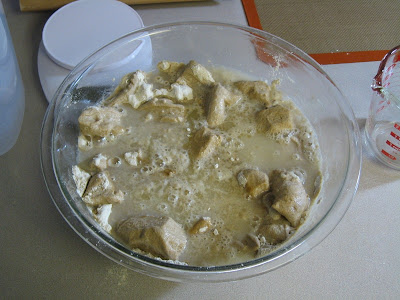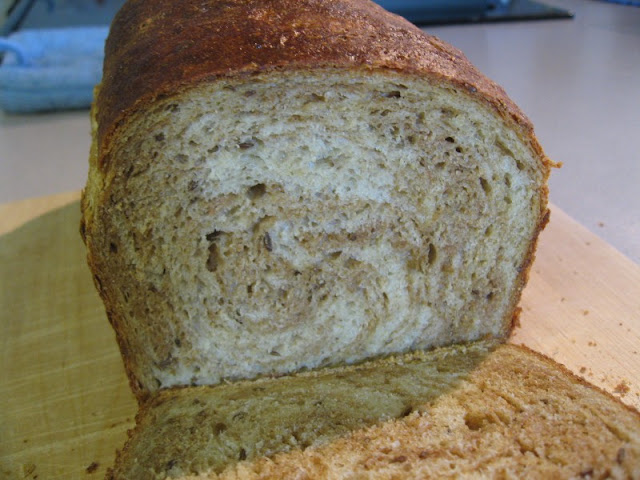This was the first time I mixed a two-loaf-dough. I've made two loaves on the same day but they have been different recipes, mixed as separate doughs, one following the other in timing. This was the first time I handled twice the dough and, with the amount of kneading LR's recipes need, that change is very noticeable. The recipe did use a sponge, so that reduced the kneading requirement a little, but it was still sizeable arm workout. I have read a lot about how the whole upper body should be involved in the kneading motion to reduce soreness in the arms and shoulder. That would mean a shorter counter or that I stand on something to help with my short stature.
The sponge
I didn't take a picture of the sponge before I put it together because I was running late. The sponge method reduces the time required for the rest of the process. The sponge consisted of half the flour, half the yeast (active dry, dissolved in some warm water), all the honey, all the yogurt thinned in some water and some salt. It forms a stiff dough that is kneaded for 5 minutes and then left to sit for 6 to 10 hours. The book also gives variations if one wants to delay this step (using refrigeration)
 |
| The sponge is ready for sit for 6 to 10 hours |
The final dough
My sponge only got to sit for 5 hours before I needed to move on in order to have bread ready for dinner (I was going to have family over for dinner). The final dough adds more flour, active dry yeast, vegetable oil and water to the sponge.
 |
| The sponge in the container had almost doubled in volume in the five hours. |
 |
| I cut the sponge in pieces ala PR's epoxy method to ensure better mixing |
 |
| After 15 minutes of kneading in the bowl, the dough was very soft and ready for it's first rise |
 |
| First rise took exactly an hour. |
The second rise
After the first rise, the dough is deflated gently, rounded and left to rise again. The second rise usually takes half the time of the first rise, 30 minutes in this case. If you have seen pictures from previous posts with the dough on the Silpat mat, you will get a feel for how much more this dough was.
 |
| Great mass of dough |
 |
| Divided into two with the handy digital weighing scale. The two pieces are rounded and left to rest for about 15 minutes. |
 |
| Shaped and ready for proofing |
 |
| Proofed. The book recommended slashing through the center. Boldly I did so, but forgot to take a picture before putting the loaves in the oven. |
 |
| When the slashes open up like they did here, it is always a good sign of oven spring |
 |
| Two slash patterns to differentiate the loaves |
 |
| Sliced thin and even without falling apart |
 |
| Thin crust and uniform crumb |
Notes
Date: Feb 20, 2011
Recipe: Yogurt Bread from Laurel Robertson's book, 'The Laurel's Kitchen Bread Book'
Flours: Whole wheat
Bread specific ingredients: Yogurt
Sweetener used: Honey
Liquid: Yogurt, water
Sponge fermentation: 5 hours
First rise time: 60 minutes
Second rise time: 30 minutes followed by 15 minutes of rounding and rest.
Proofing time: 60 minutes
Comments: Added 2 tsp of vital wheat gluten (recipe called for whole wheat bread flour) to the sponge and then 1 tsp in the final dough (1½ tsp per loaf). Should try making this recipe without the vital wheat gluten to see how much it affects the rise and the taste. (PR doesn't like the taste that v.w.g gives to bread). 1 tsp of yeast per loaf is not much at all compared to 2½ tsp in PR's bread. I like that the recipe uses less yeast. 1½ tbsp honey and 2 tbsp of oil per loaf are not unreasonable either. The bread sliced well and was great with choley (Indian dish with garbanzo beans (chickpeas) in spicy tomato sauce), for a tofurky sandwich for lunch and with almond butter for breakfast.
-RPH











































